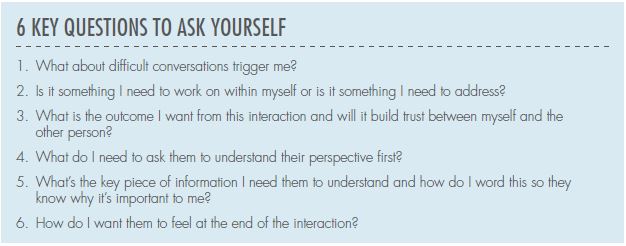Emmy and AACTA Award-winning producer turned screen sector executive coach
Ellenor Cox provides insights, tips and strategies on how to provide feedback and mentorship, master difficult conversations and keep a team motivated.
There’s a saying in the film business: No one outside the industry knows what the producer actually does and no one in the industry wants to be the producer.
Why the role of the producer is misunderstood is relatively straightforward. It’s easy to imagine the director on set calling ‘Action!’, but what on earth is that producer person doing all day on the phone or the computer?
However, it’s insightful that there is a reticence for this leadership role from insiders who better understand the nuances of the different roles on set.
The main reason for this reticence is the producer is the person tasked with having the toughest conversations of all: be it the hiring and the firing; the negotiating, pitching and hustling; the taking people aside to discuss performance and attitude issues, and the morale boosting talks when everyone is feeling overworked and underpaid.
The producer, and by extension their production team and other heads of department, are ultimately the ones responsible for holding others to account if they’re not performing.
If this is the situation, then there are three options available at this point. One is to naively hope that things will improve. A second option is to grin and bear it, making a mental note to never work with that person again. Or the final option is to provide them with constructive feedback. The latter option is rarely chosen as this this is seen as consciously entering into the perceived treacherous waters of ‘a challenging conversation’.
Why is giving challenging feedback so hard?
Research indicates 65 per cent of employees wish they could receive more feedback (Ken Blanchard: The One Minute Manager).
Self-awareness has its gaps. Receiving feedback can be tough and uncomfortable, but we get insights into our blind spots and are provided with an opportunity for improvement. Without this feedback, we’re left wondering why we never get asked back to work on recurring shows or why we’re struggling to find work when all our peers seem booked out.
Most people will explain that they don’t want to give tough feedback for fear of hurting the other person’s feelings. But what is really going on here?
Rather than protecting the feelings of the other person, the feelings that they’re really protecting are their own.
The reality is that we don’t give feedback because we don’t want to feel uncomfortable ourselves. Most challenging conversations are ripe for generating discomfort because the conversation might be uncertain and difficult, the other person might become emotional, or worse still, end up lashing out and criticising or judging us instead.
So when we wonder ‘How can I give this feedback nicely?’, what we’re really meaning is ‘How can I give this feedback without having to feel uncomfortable myself’?

How do I become more confident with difficult conversations?
Great leadership comes from getting comfortable with feeling uncomfortable and recognising that facing challenging conversations head on is the key to gaining confidence in this area.
Remember when you first learnt to drive and how challenging it was? Now look at your confidence levels around driving. This didn’t come from memorising a ‘how to drive’ manual. Instead it came from getting in the driver’s seat and practicing!
Confidence is a muscle that requires effort to create mastery. However, having a script in these challenging circumstances can certainly help, so here are some strategies on how to navigate these sorts of conversations.
Be direct
• In the words of Brene Brown, ‘To be clear is to be kind’
• Difficult conversations become even more difficult when the delivery is muddled
• This is not the time for ‘feedback sandwiches’ or excess of compliments
• Be honest, as this allows for your nerves and preserves the other persons dignity and importantly, shows your vulnerability and your sensitivity for the subject
Be specific – know your purpose and your goal or outcome
• Be honest, thorough with your feedback and fully clarify why you’re having the conversation
• State the problem and provide concrete examples
• Offer suggestions on how to improve
• The more clarity you can provide the better the critique will be received
• Be super clear in your mind of your goal and the desired outcome
• Explain why this is important to you
• Be clear on the actions that you’d like them to take
Be prepared
• Plan out the conversation and think ahead about what you want to say and how
• Prepare them for the reason for your meeting, by saying something like: “Can we have a chat, as I need to give you some feedback that you might not want to hear.”
• Have answers to how they might respond
• Have the facts
• Think about it from their perspective
• Remember that the more preparation you do, the less flustered you’ll be
Ask questions
• Put aside your view and let them explain their side of the story; try to understand them
• Listen more and talk less (that’s why we have two ears but only one mouth!)
• Refrain from starting a question with the word ‘why’ as this can provoke defensiveness. Instead, use more open questions like ‘What was your intention there?’ or ‘How do you see it?’ or ‘Tell me more about that?’
• If they get upset say ‘I’m keen to help. What can I do?’
Watch your language
• Speak slowly, as slow means calm and calm means thinking versus reacting
• Instead of saying ‘Stop yelling’, try ‘Please speak more slowly. I’d like to help’
• Refrain from saying ‘Uh huh’, especially on the phone, as it sounds passive aggressive
• Focus on the issue, not the person, and the situation or the behaviour instead of yourself
• Start sentences with ‘I’ instead of ‘You’. For example, ‘I was disappointed that you didn’t meet the deadline’ instead of ‘You didn’t meet the deadline’
Be empathetic
• Put yourself in their shoes
• Avoid talking about yourself
• Let the other person be upset
• Acknowledge their feelings and views; ‘It’s okay to be upset about this’
• Confirm and clarify your understanding of what they have said and validate where appropriate ‘I can see this has been frustrating for you’/ ‘It sounds like this is upsetting you’
Offer a solution
• Offer suggestions on ways to improve
• Reassess if your position has changed because of new information
• Develop solutions together
• Agree on a way forward
• Instead of saying ‘I want’ what about, ‘I have decided to try’, ‘I wonder whether’, ‘I think I’d prefer’
• Close with a circle back and opportunity to continue the discussion further if need be
Get proper closure
• Tell them why this is important to you
• Tell them what you would like them to do
• Ask if they need any support from you
• Confirm that this is okay for them, and if not, what is their idea
• Offer to circle back to discuss more or again at a future time
Ellenor provides individual and group coaching and mentoring sessions and has extensive free materials on her website.
This article originally appeared in IF Magazine #201. Subscribe to the magazine today via our special digital introductory offer of two issues for $2.


